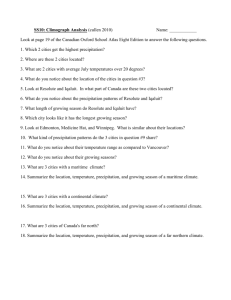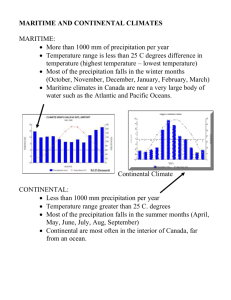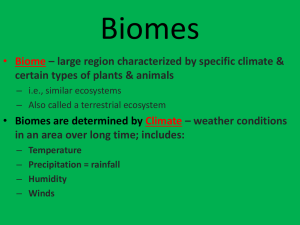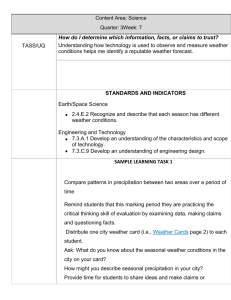Biodiversity in a Global Context Robin Allaby
advertisement
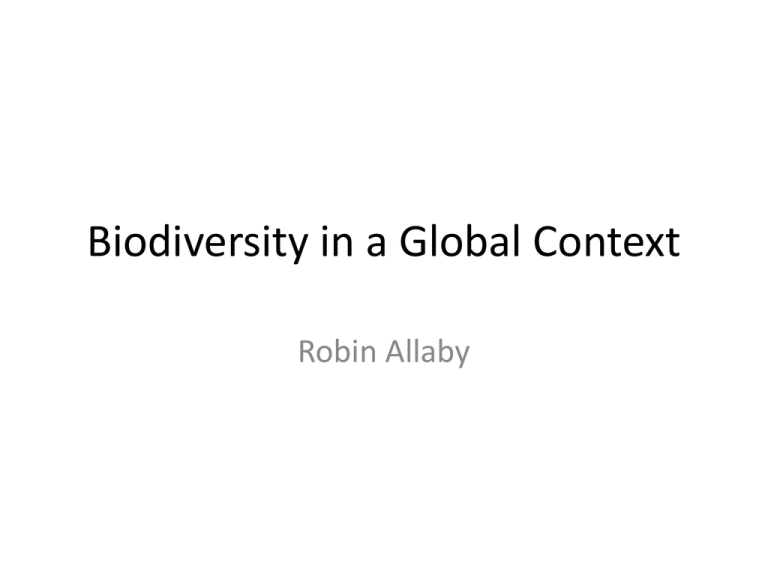
Biodiversity in a Global Context Robin Allaby Outline • • • • Determinants of the world’s major biomes Species diversity across the biomes The latitudunal gradient of diversity Global threats to diversity Cook’s 2nd voyage 1772-1775 Johann Forster Observations Made During A Voyage Around the World (1778) Holdridge Life Zone Classification Holdridge Life Zone Classification Tundra • short growing season (50 days) • permafrost • low precipitation (< 40cm/year) • low productivity (1g/m2/day) • seasonal difference in temperature Boreal • 2 month summer • precipitation (25-100cm/year) • warmer summer (up to 23˚C, frost free) Cool temperate • 4-6 month growing season • 15-25˚C July isotherm, -10 - +15˚C January isotherm • still dominant winter/summer (temperature driven) cycle • range of precipitation levels Cool temperate Temperate rainforest Cool temperate Grasslands, steppe Warm temperate dry forest wet forest • transition to both temperature and precipitation driving season • 6-12 month growing season, almost no frost Warm temperate sclerophyllous community • drought tolerant • fire adapted Fynbos, chaperal, mediterranean, heath Hot desert • precipitation < 25 cm/year • high insolation • high diurnal variation • very high temperatures (up to 50˚C) Savannas • season driven by precipitation • short rainy season 3-4 months • long dry season 8-9 months • precipitation 50-200cm/year • warm all year round Tropical seasonal forest • rainy season 6 months + • dry season 6 months – • precipitation 150-200cm/year Tropical rainforest • precipitation > 200cm/year • precipitation > 10cm/month • temperature 21-30˚C, diurnal variation wider than seasonal • contants high humidity Montane environment The effect of altitude: Tundra-like within rainforest region: • temperature range wide • high UV • low oxygen levels Aquatic systems • oxygen • nutrient River systems • linear dependency • rate of flow oligotrophic eutrophic Aquatic systems • seasonal stratification Lake systems Aquatic systems • deep low nutrient low productivity many species • shallow high nutrient supplied by rivers high productivity Ocean systems Biodiversity across biomes Scales of diversity • α diversity – small scale, homogenous area • β diversity – rate of change in species composition across habitats • γ diversity – rate of change in species composition across landscape gradients Endemism in different taxa Plate tectonics Papua New Guinea Eurasian e.g. Parsonsia Australoid e.g. Nothofagus Latitudinal gradient Must be a difference in one or more of: • speciation rate • extinction rate • immigration Gradient causes 1: Area Gradient causes 2: energy More energy /cm2 = more biomass Gradient causes 3: disturbance Greater distal disturbance Global threats to biodiversity Global threats to biodiversity A worsening situation Millenium Ecosystem Assessment

